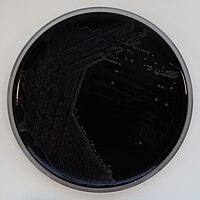
Photo from wikipedia
In addition to the Gram-negative bacterium Bordetella pertussis, the etiological agent of pertussis, Bordetella parapertussis also causes respiratory infection in humans, with a mild pertussis-like disease. These bacteria are genetically… Click to show full abstract
In addition to the Gram-negative bacterium Bordetella pertussis, the etiological agent of pertussis, Bordetella parapertussis also causes respiratory infection in humans, with a mild pertussis-like disease. These bacteria are genetically closely related and share many virulence factors, including adhesins and toxins. ABSTRACT Bordetella parapertussis causes respiratory infection in humans, with a mild pertussis (whooping cough)-like disease. The organism produces a brown pigment, the nature and biological significance of which have not been elucidated. Here, by screening a transposon library, we demonstrate that the gene encoding 4-hydroxyphenylpyruvate dioxygenase (HppD) is responsible for production of this pigment. Our results also indicate that the brown pigment produced by the bacterium is melanin, because HppD is involved in the biosynthesis of a type of melanin called pyomelanin, and homogentisic acid, the monomeric precursor of pyomelanin, was detected by high-performance liquid chromatography-mass spectrometry analyses. In an infection assay using macrophages, the hppD-deficient mutant was internalized by THP-1 macrophage-like cells, similar to the wild-type strain, but was less able to survive within the cells, indicating that melanin protects B. parapertussis from intracellular killing in macrophages. Mouse infection experiments also showed that the hppD-deficient mutant was eliminated from the respiratory tract more rapidly than the wild-type strain, although the initial colonization levels were comparable between the two strains. In addition, melanin production by B. parapertussis was not regulated by the BvgAS two-component system, which is the master regulator for the expression of genes contributing to the bacterial infection. Taken together, our findings indicate that melanin produced by B. parapertussis in a BvgAS-independent manner confers a survival advantage to the bacterium during host infection. IMPORTANCE In addition to the Gram-negative bacterium Bordetella pertussis, the etiological agent of pertussis, Bordetella parapertussis also causes respiratory infection in humans, with a mild pertussis-like disease. These bacteria are genetically closely related and share many virulence factors, including adhesins and toxins. However, B. parapertussis is clearly distinguished from B. pertussis by its brown pigment production, the bacteriological significance of which remains unclear. Here, we demonstrate that this pigment is melanin, which is known to be produced by a wide range of organisms from prokaryotes to humans and helps the organisms to survive under various environmental stress conditions. Our results show that melanin confers a survival advantage to B. parapertussis within human macrophages through its protective effect against reactive oxygen species and eventually contributes to respiratory infection of the bacterium in mice. This study proposes melanin as a virulence factor involved in the increased survival of B. parapertussis during host infection.
Journal Title: mSphere
Year Published: 2021
Link to full text (if available)
Share on Social Media: Sign Up to like & get
recommendations!